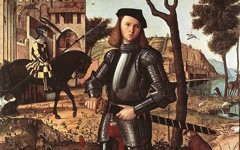Carpaccio’s Presentation of Jesus in the Temple (1510)

Carpaccio, Presentation of Jesus in the Temple (1510) Tempera on panel. Accademia, Venice
Click image to enlarge.
Sometime in the last years of the fifteenth century, music-making cherubs began to appear at the base of tall Venetian altarpieces. Cima da Conegliano painted several around 1496-1500. The better-known Carpaccio followed suit in 1510 in this massive altarpiece still in Venice. Below the apparent subject matter, the Presentation of Jesus in the Temple, are three little superfluous cherub-like boys each playing a different musical instrument.
Click next thumbnail to continue
The most charming uses a lute very close to where Carpaccio placed his signature on a small piece of paper (known as a cartellino). The proximity of Carpaccio's name to the lute-player, and the passion with which the Venetian elite prized music, strongly suggests that the music-playing boys are visual alternatives for the art-making Carpaccio. Infants within the allegories of Christian mysteries symbolize newly purified initiates or minds "born again" as we would say today. These boys represent Carpaccio's divine mind "painting" (or "creating") the biblical scene we see above. Many artists later used music in similar ways, most notably Veronese in his Marriage Feast at Cana (1563) where a group of actual artists including both Titian and Veronese play music for the guests.
More Works by Carpaccio
Notes:
Original Publication Date on EPPH: 21 Dec 2011. | Updated: 0. © Simon Abrahams. Articles on this site are the copyright of Simon Abrahams. To use copyrighted material in print or other media for purposes beyond 'fair use', you must obtain permission from the copyright owner. Websites may link to this page without permission (please do) but may not reproduce the material on their own site without crediting Simon Abrahams and EPPH.



